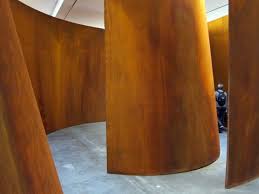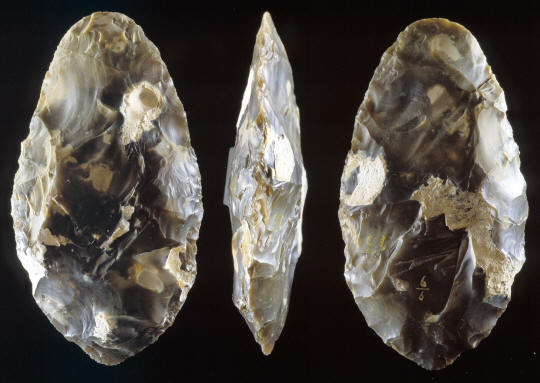A million years of producing stone tools may have established the neural pathways necessary for language. One and a half million years ago the Ascheulean hand ax was the I-Phone of its day. The mental skills required for its development like learning the material qualities, and predicting the outcome of certain strikes upon its surface and more, provided the same complex, sequential thoughts towards an end that are necessary for language development. As it turns out tool making and language are accomplished in the same area of the brain. (
Link to program What Makes Us Human, 10/10/12)
 |
| Richard Serra, Junction |
Richard Serra, the prominent sculptor of magnificent environments made of gargantuan, rusted, steel plates, says in his
interview with Charlie Rose, that he creates his own tools. He was using a paint stick that had a wrapper that took considerable time to peel as he worked. It took so much time and made him so frustrated that he named the piece "Abstract Slavery". His solution was to take many paint sticks and melt them down into loaf pans to create a brick that he could draw with using both hands. Drawing is a practice that is very important to Serra to keep him loose and disciplined.
He says that the artists he finds most interesting make their own tools and procedures. siting (Jasper) Johns' stencils and Pollacks drips, Seurat's (Conte') Crayons. "You're not going to build art out of the art store. You have to invent your own tools and your own procedures."
When I heard these two things just weeks apart I thought about the comparison of ancient man developing tools to build language development and contemporary artists creating tools which aid to creative language. So I believe that by developing your own tools and processes you are also developing your own art language. It is your own vocabulary. It is the realization of the definition of creativity, using things that exist to make things and ideas that did not previously exist.
 |
| Archeology experimentation. Wash test. The batting shreds! |
I am often asked, what is the gold that you use on your work? How do you get it to stick? Where are the stitches in your work? Is that sewing? The answers to these questions are my own tools, my own art language. The tools, materials and processes used in my first Archeology pieces took three months to develop.
The creative process takes time and it requires experimentation. I make samples, keep notes, buy new products, and try old ones.
During the creative process, when I have an idea for something that I do not know how to make, I will record a note of the idea. I do not let it go. I may be stuck because I do not see the solution then, but in working it out one will come. Sometimes many new ideas come as a result of the exploration of this one original problem.
This is the meaning of thinking outside the box. When you get to a wall, choose not to see the wall. It reminds me of a story about a fly who is trying to fly outside but continually flies into the glass. Defeated he lands on the window sill, just in front of the open window. Do you sit there on the sill in front of the solution or do you try new ones?
I encourage you to develop your own tools, and at the same time develop your own art language.



